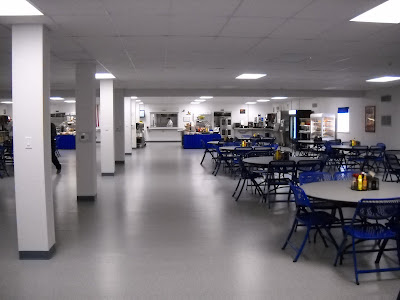
On Thursday we departed the Bismarck State College parking lot at 7:00 am and returned thirteen hours later, 8:00 pm. Only twice did we step off the bus, once at the location pictured for noon lunch and once at a Cenex in Stanley, ND. I stood in the middle of this man-camp dining facility and shot towards the kitchen/serving area, but this picture gives a poor scale; the room was very large. Our walk-through of the man-camp was interesting. Hallways ran out from the hub like tentacles. Laundry, exercise room, computer room, etc. gave the workers the things they needed be satisfied. This camp was said to be quite small, about 350 beds. I asked what do you do about law and order if someone comes in drunk. "Oh, we've got our own police force." A joke overheard: If you want to find your car in the Dickinson Wal-Mart parking lot, just look for the North Dakota license plates. The first six plates I looked at as we drove into this camp's parking lot came from six different states.
We learned that 193 rigs presently work in ND. Two experts accompanied us: Lauren Donovan, a reporter for the Bismarck Tribune and Drew Combs working for the state. He has worked around the world in the oil business, and she knows how to ferret out information from people to become very knowledgeable.
North of Dickinson, Donovan pointed out all the large facilities being constructed for oil business. The farther north we drove the more truck traffic we encountered. Communities we visited: Killdeer, Watford City, Williston, Minot, Stanley. One question I've had for some time was answered. So often I've seen long trailers coming down I-94 with just one rear axle. I saw hundreds of them in the oil patch. They hold liquid for the fracking process.
McKenzie County does not have a system set in place for zoning, or at least not a good one, so we saw many random collections of campers huddled together, here and there. Step-on guides pointed out the huge development of housing in their communities. One said Halliburton was especially aggressive in getting their people into permanent housing, the better to retain workers. Miles and miles of blue water line lay along the road waiting to be buried and put into service to supply the huge demand.
In Watford City a line of oil wells sat on the north side. From them oil pipe goes down, then extends two miles horizontally to the south under the city. Hard to comprehend. Most anytime we'd come to a stop light, traffic would have backed up two blocks waiting for it to change. All over we'd see patches of ground scraped clean of sod waiting for something to happen, whether it be a new oil well site, a storage yard, a parking lot, a site for new housing, etc. The wife said, "We thought we had a lot of construction going on." Nine thousand trucks a day pass through Williston.
Near Ross, the guide pointed north to the open prairie and told us one person's land sports 27 producing wells that bring him about five thousand dollars each per month. The Cenex C-Store in Stanley serves up one million dollars of seven inch pizzas each quarter. I saw a few walk out the short time we were there. All in all, the oil patch boggles the mind.
